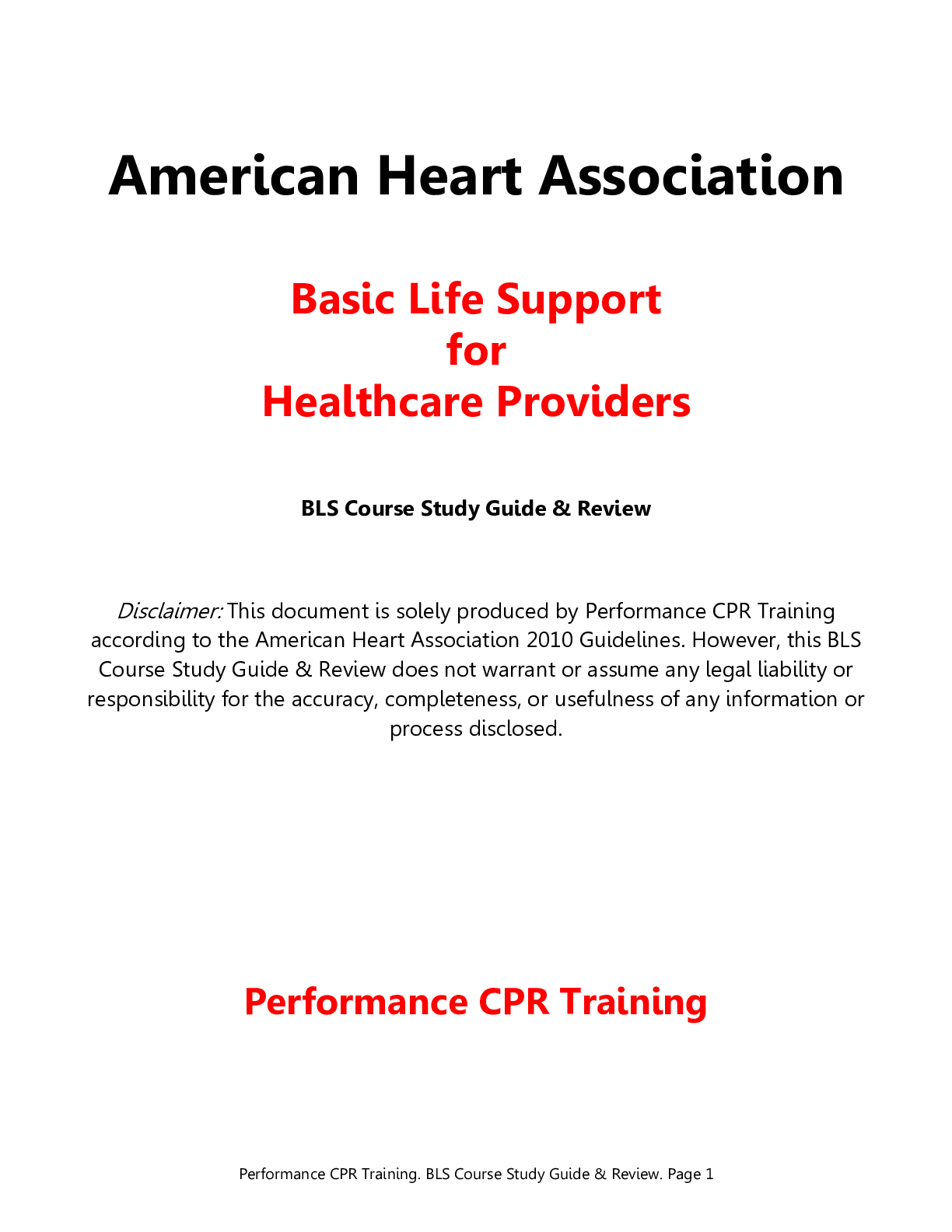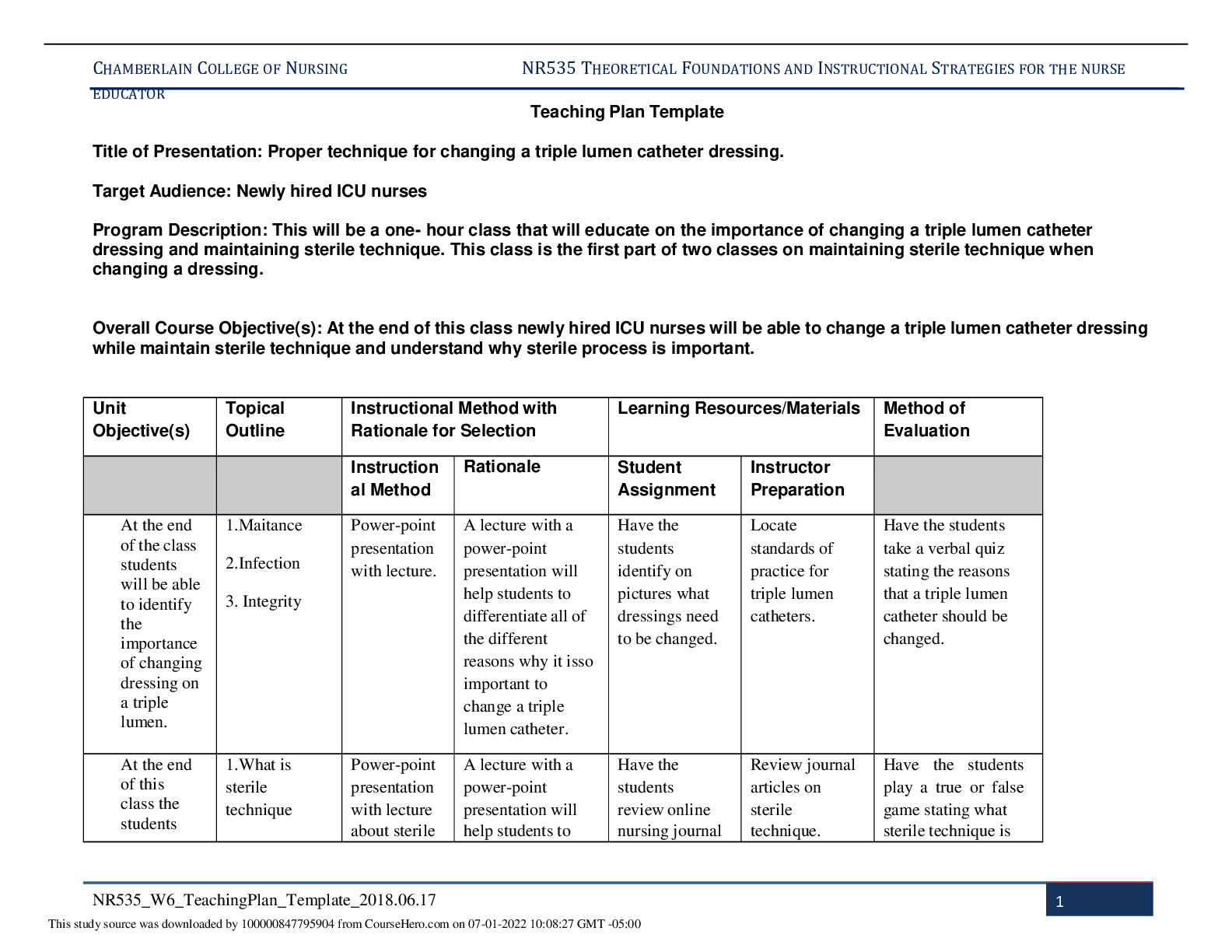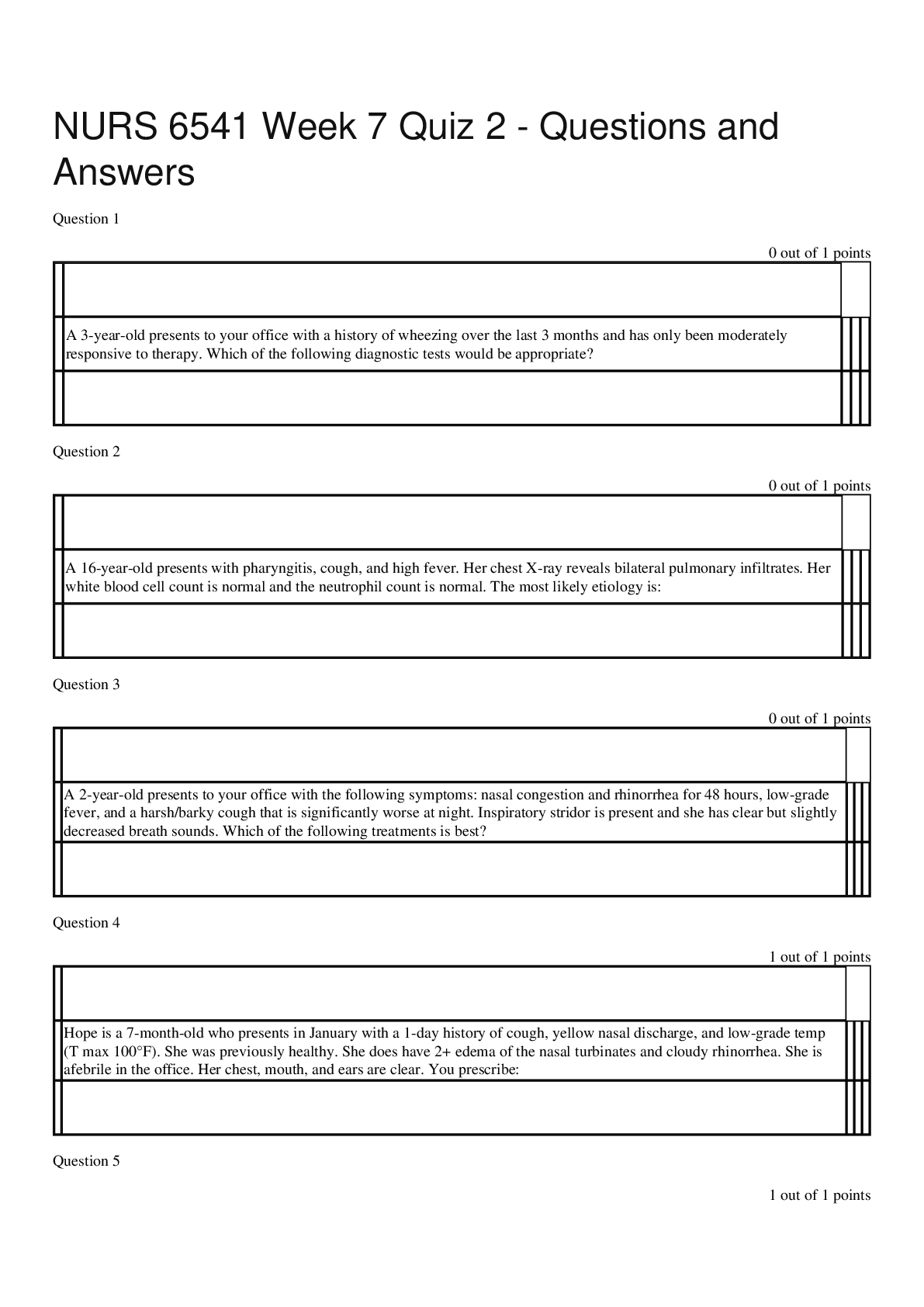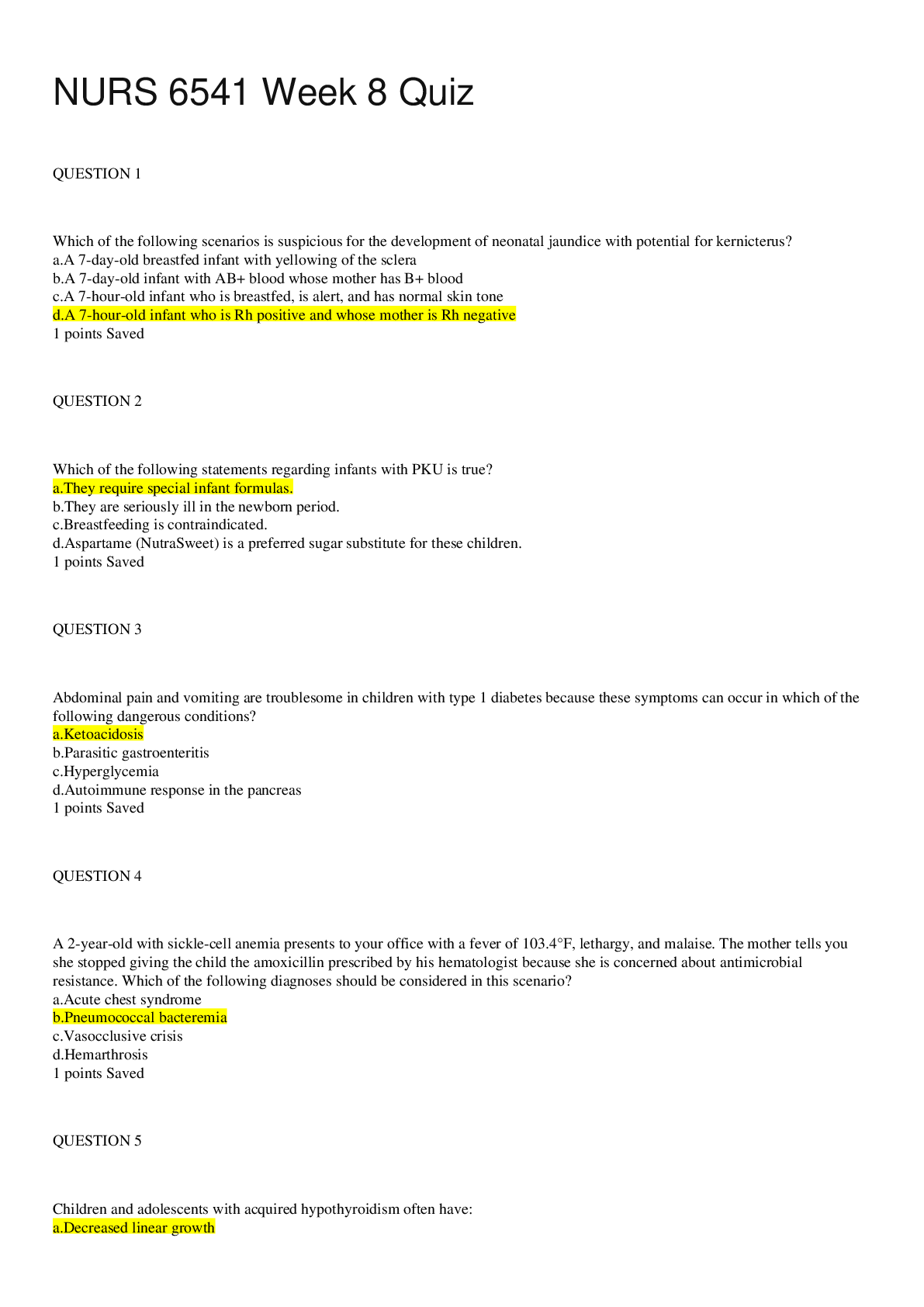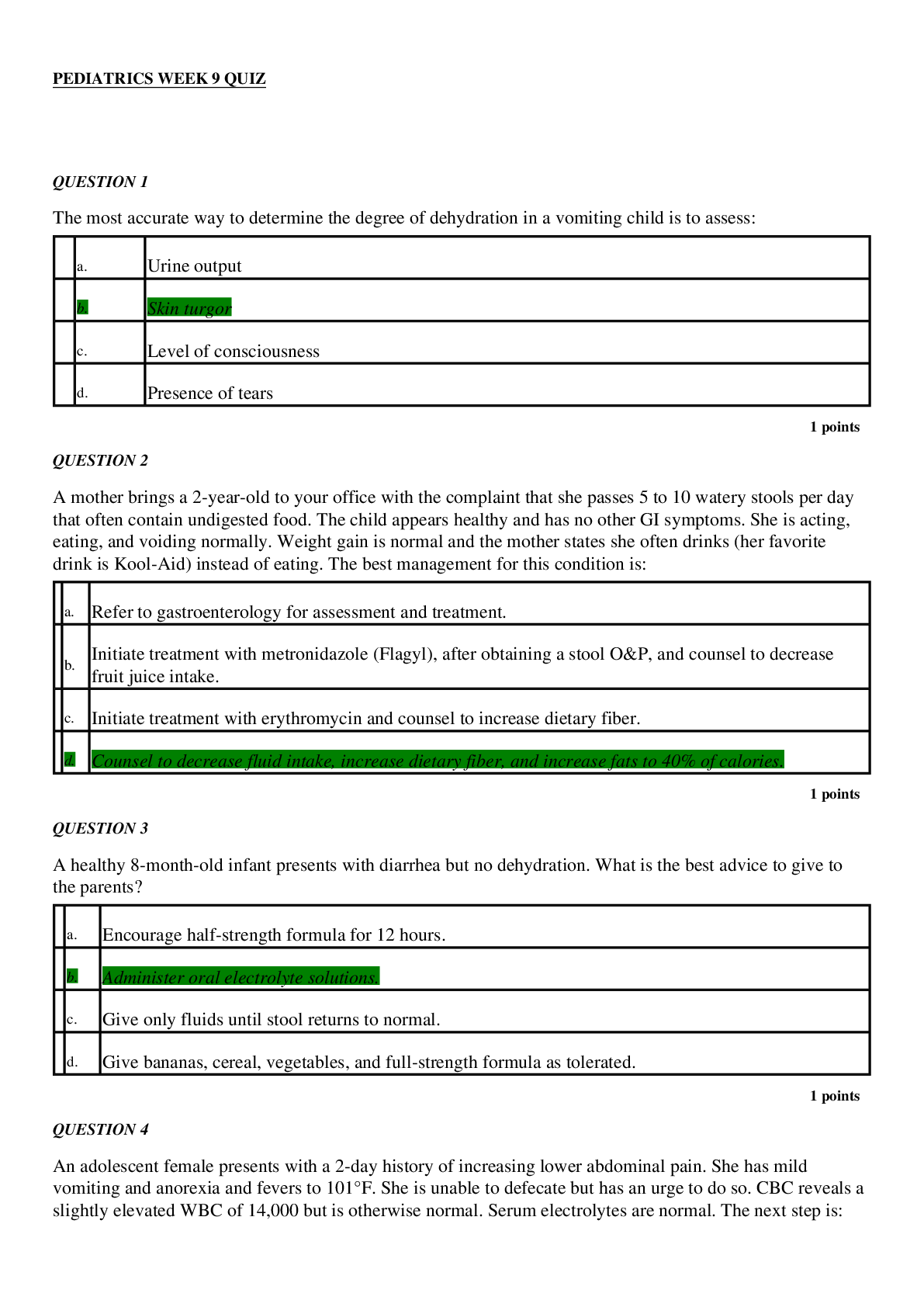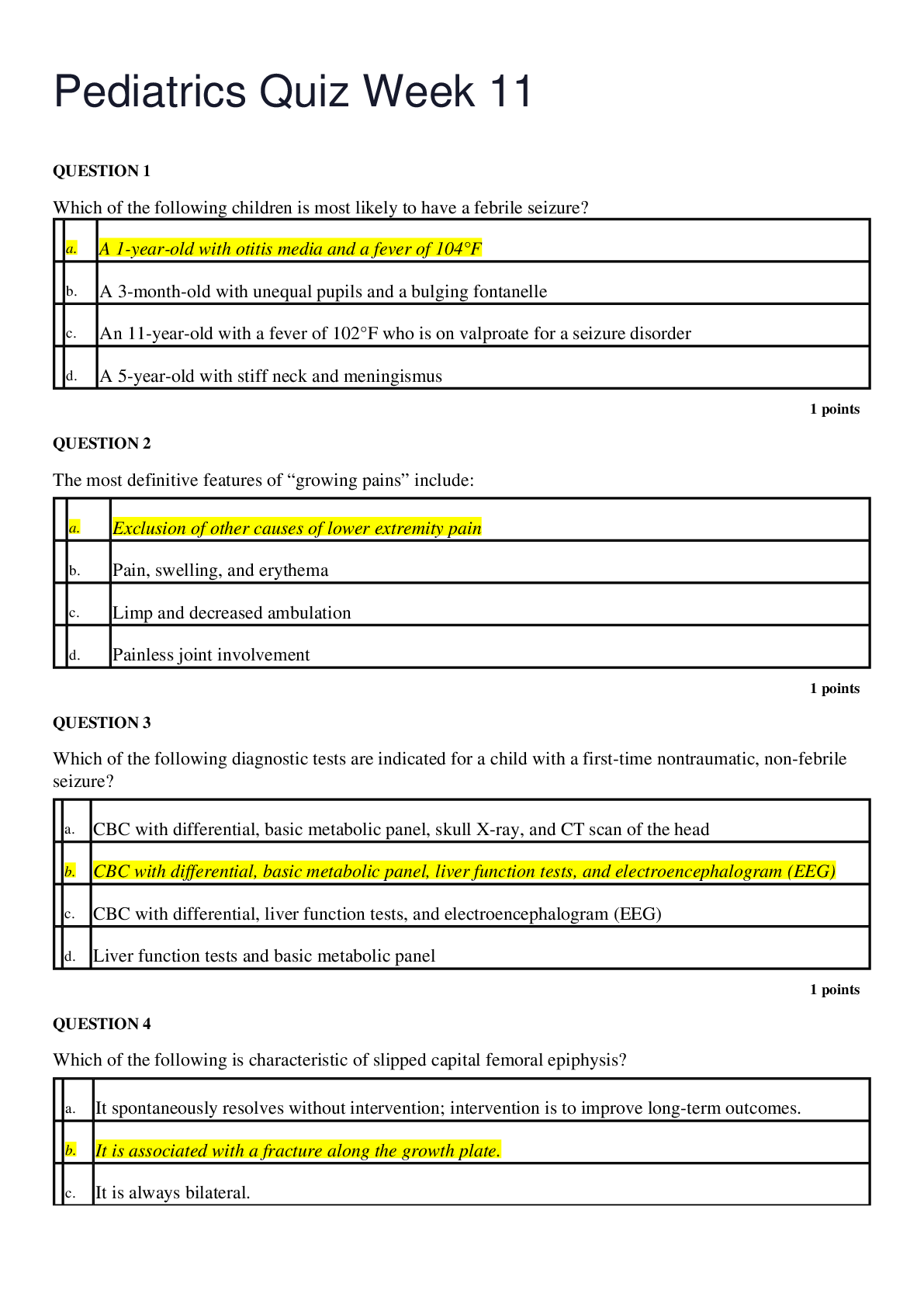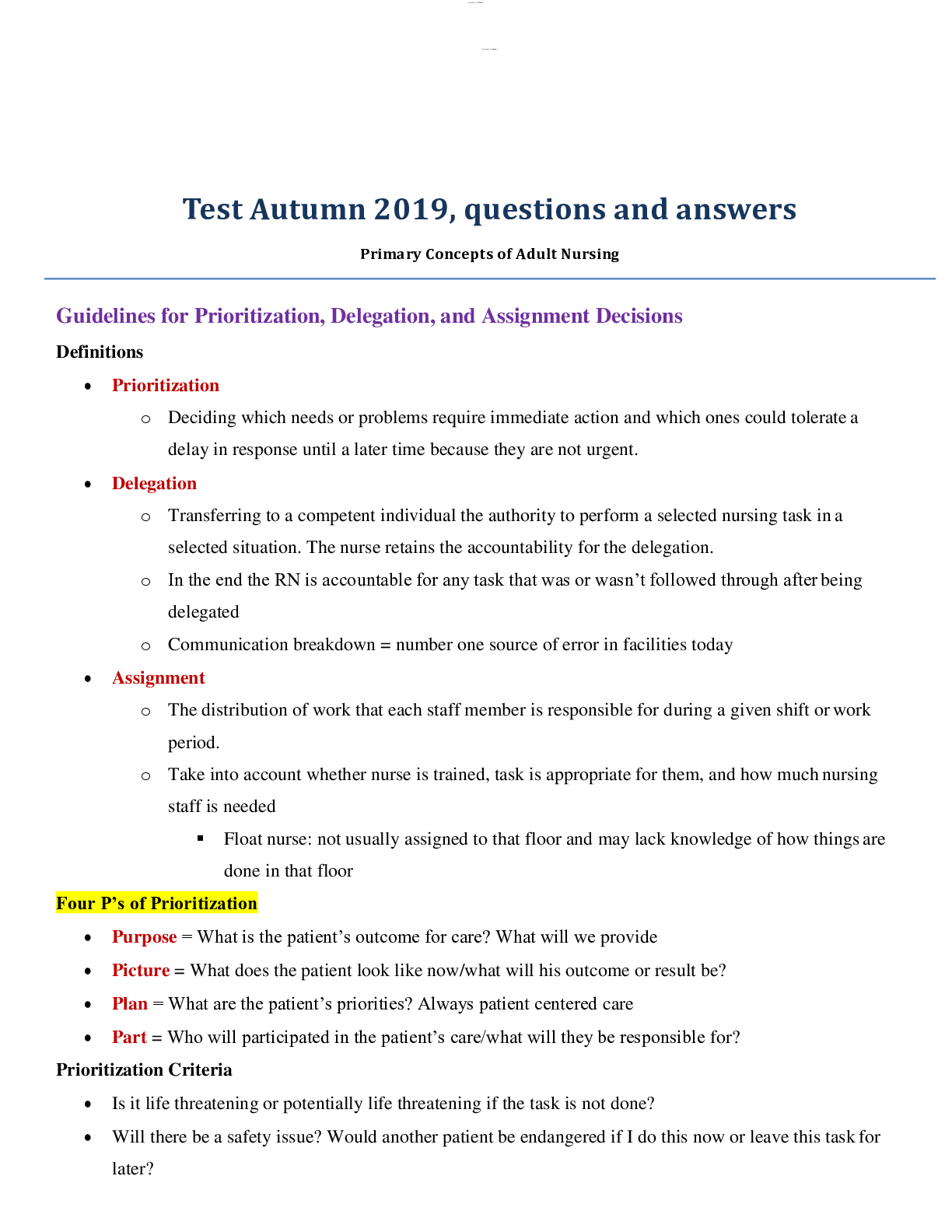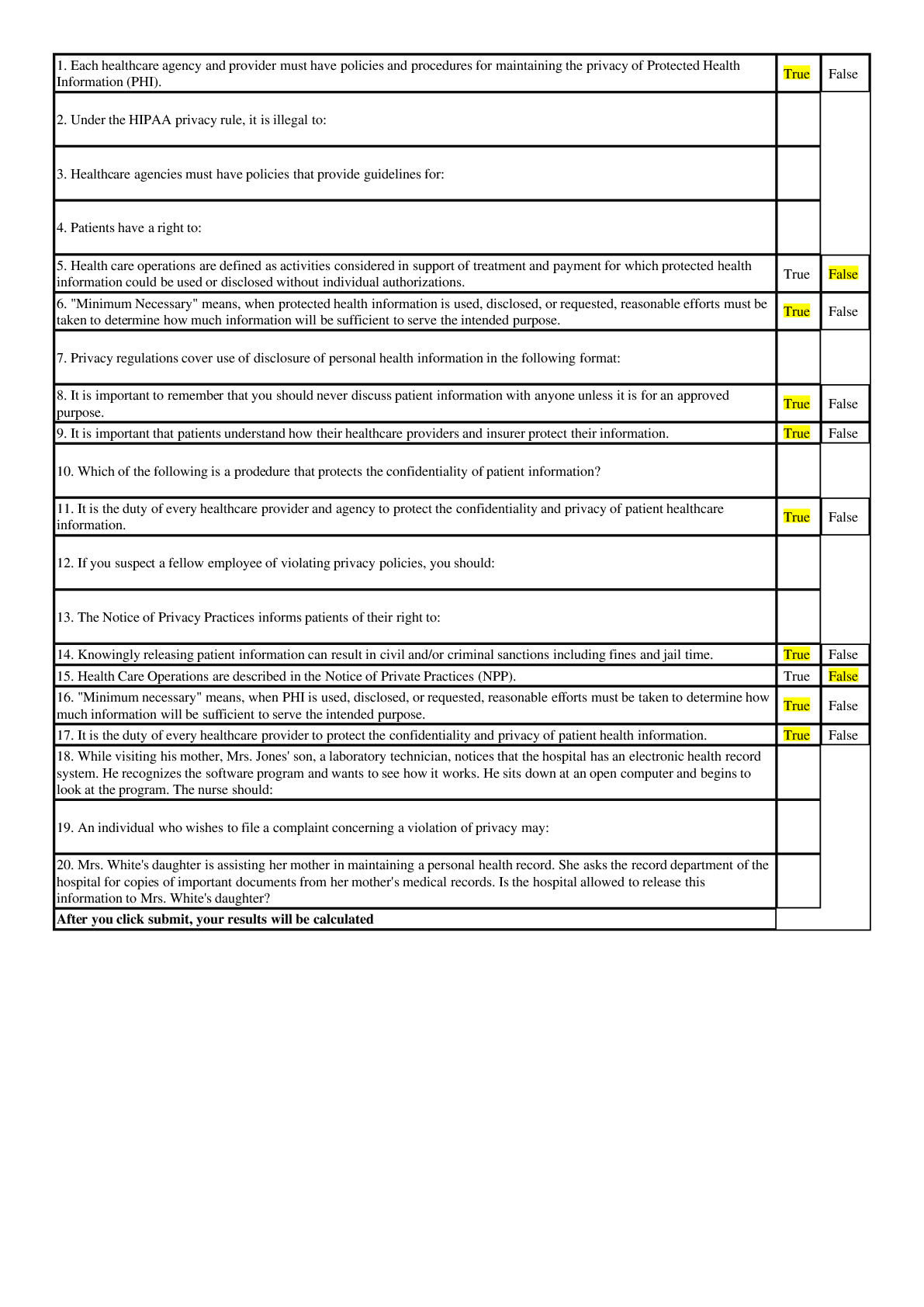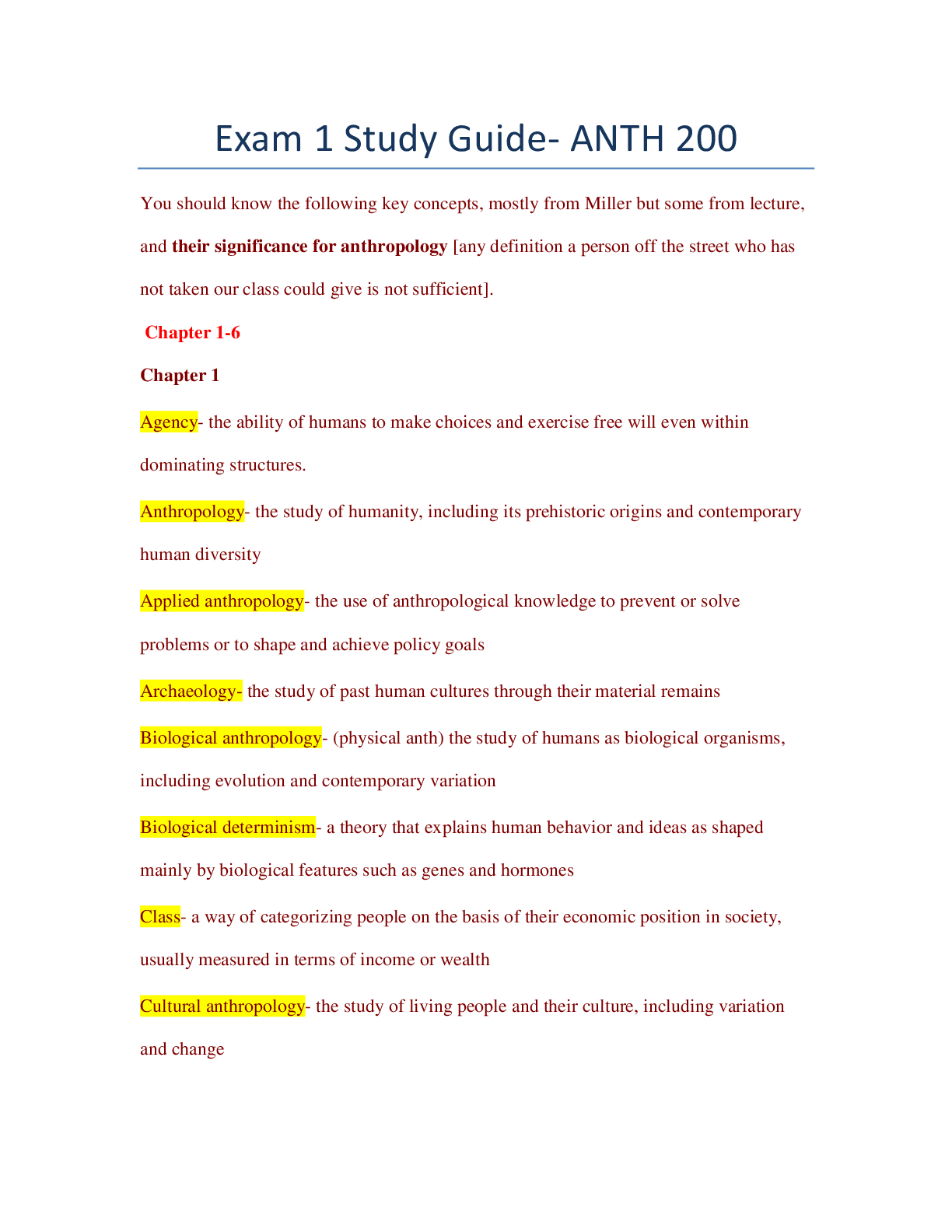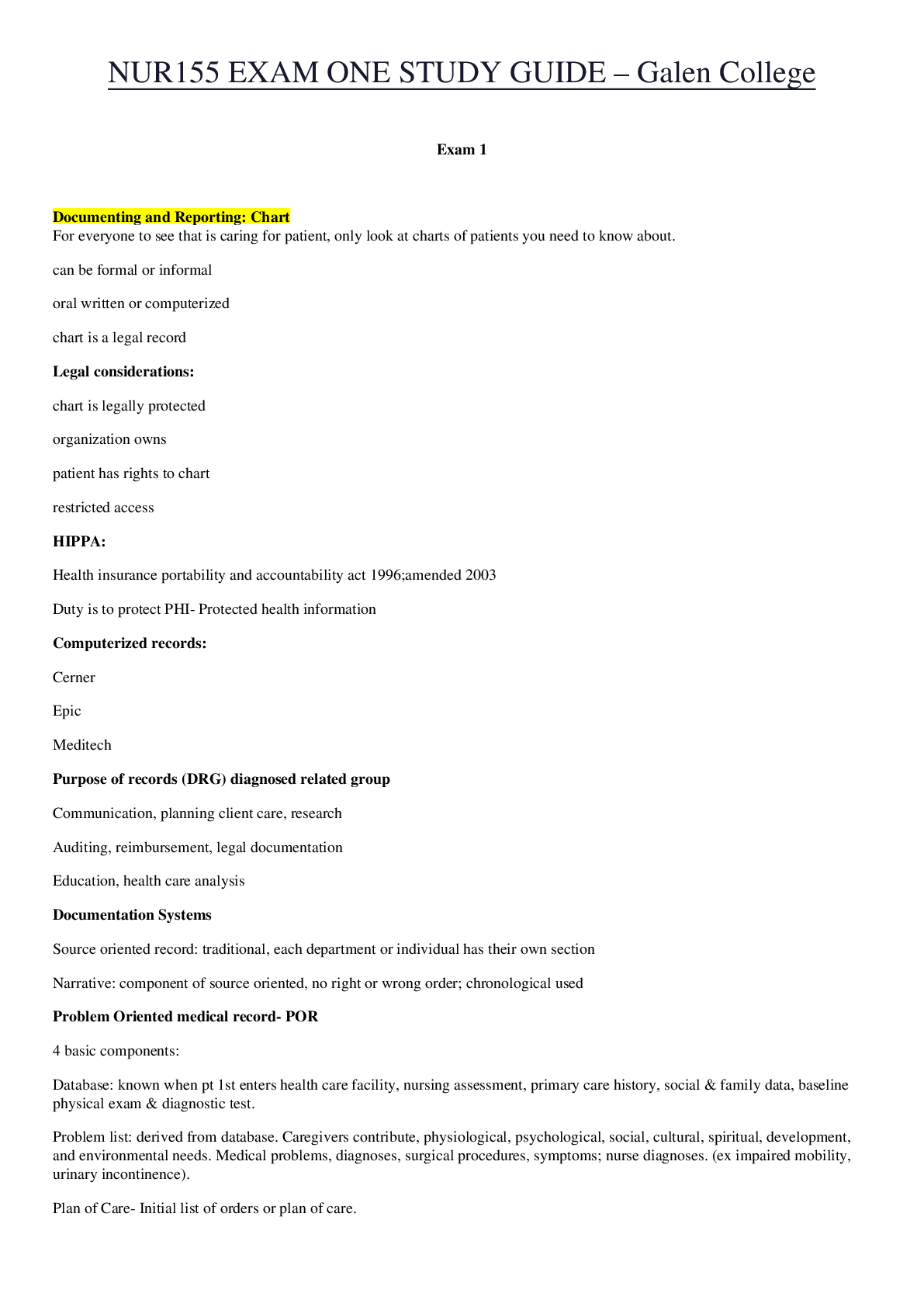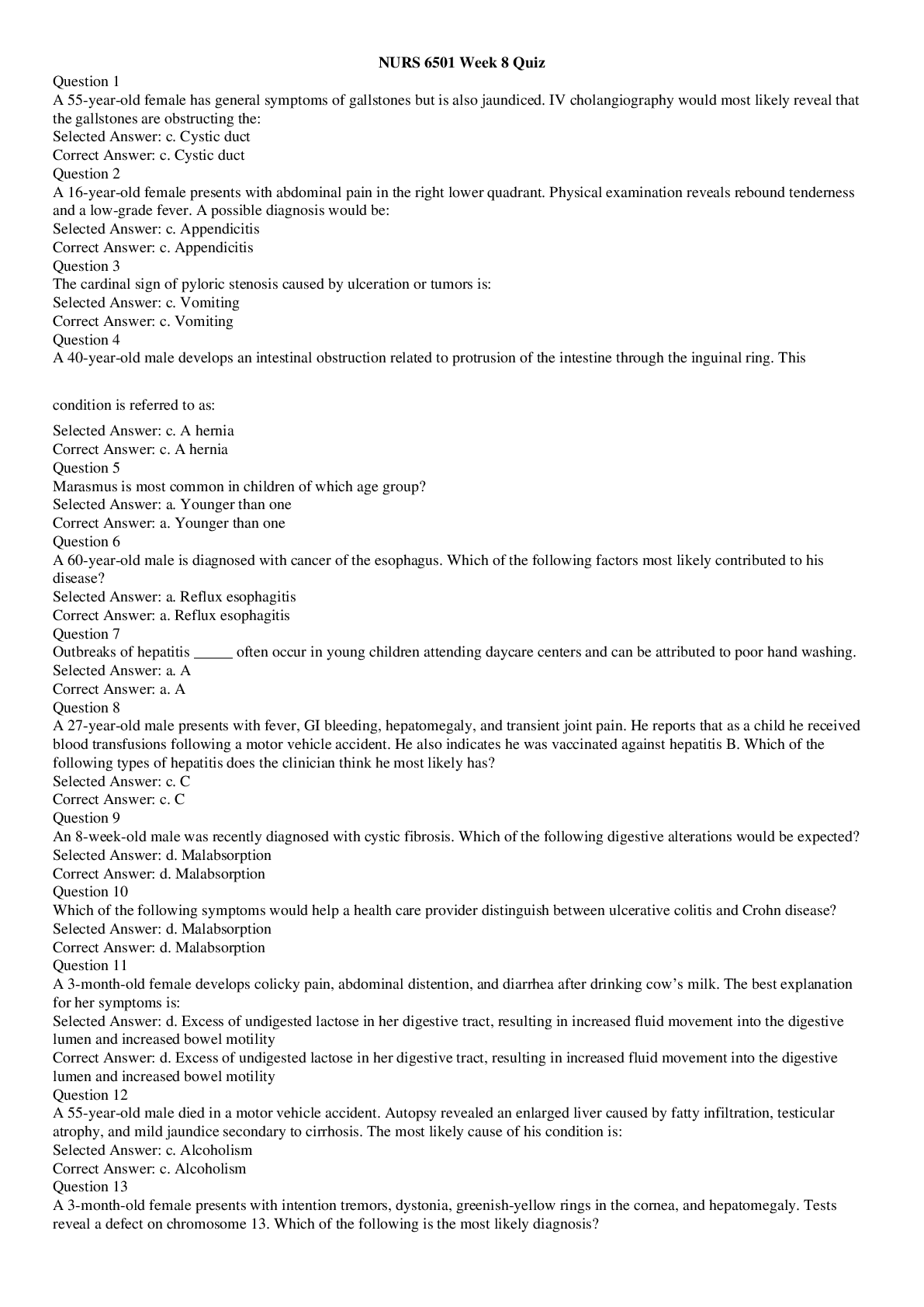*NURSING > STUDY GUIDE > NR 340 Week 3 Exam One Study Guide | Well explained Questions and Answers | 100% GUARANTEED PASS. (All)
NR 340 Week 3 Exam One Study Guide | Well explained Questions and Answers | 100% GUARANTEED PASS.
Document Content and Description Below
Chapter 1 – Overview of Critical Care Nursing (6 questions) 1. Define and discuss the purpose and functions of professional organizations that support critical care practice. a. Support critical... care nurses and practice b. Validate knowledge, promote professional excellence, help nurses to maintain up- to-date knowledge 2. Certification options for critical care nurses. a. AACN Certification is based on synergy model of patient care and oversees process b. Bedside practice: CCRN (adult, neonatal, and pediatric), PCCN (those working in step-down units) c. Advanced practice: CCNS (critical care clinical nurse specialist), ACNPC (acute care nurse practitioner) d. Subspecialty certification: cardiac medicine, cardiac surgery 3. Standards of professional practice for critical care nursing, what is synergy model. a. Guide clinical practice, establish goals for patient care, provide assessment of outcomes b. Synergy model – needs of patients and families drive practice 4. What are current trends and issues in critical care nursing? a. Trends – collaboration, communication, reduce hospital readmission rates, increase use of technology, telemedicine b. Issues – critical care patients more complex, increasing costs of care, aging population and workforce, transfer of patients from the ICU while still acute 5. Organization that support critical care nursing? a. American Association of Critical Care Nurses (AACN) – vision is driven by the needs of critically ill patients and families b. Society of Critical Care Medicine (SCCM) 6. Purpose of National Safety Goal. a. Communication, medication safety, reduce infections, reconcile medications b. Accurately identify patient, medication reconciliation across the continuum of care, reduce risk of HAI’s Chapter 2 – Patient and Family Response to Critical Care (6 questions) 1. Nursing interventions to reduce stress to the family members. a. Modification of environment – noise reduction (acoustical tiles/design, sooting music, private areas for communication), adequate lighting (natural lighting, night-day synchronization), design of new units to promote health and safety 2. Impact of critical care hospitalization on the patient and family. a. Stress, anxiety 3. Family needs and family-centered nursing interventions. a. Needs – receiving assurance, remaining near patient, receiving information, being comfortable, having support available b. Interventions – facilitate visitation, provide information, encourage family involvement in patient care, consider family presence during procedures 4. Impact of family presence during resuscitation. a. Able to witness that everything possible has been done, reduced anxiety and fear about what is being done 5. Know the most stressors associated with mechanical intubation to patient a. Alarms that sound from various devices b. Bright, fluorescent lights c. Lack of day-night cues d. Sounds from the ventilator e. Loss of privacy 6. Nursing strategies to help families cope with the stress in the critical area. a. Provide daily updates, explain the equipment used, encourage family to take notes, provide continuity of care Chapter 3 – Legal and Ethical (6 questions) 1. Ethical principles and legal concepts related to critical care nursing. a. Autonomy – right of self-determination concerning medical care b. Beneficence – duty to prevent harm, remove harm, and promote the good of another person c. Nonmaleficence – not to intentionally inflict harm d. Justice – fair distribution of healthcare resources e. Veracity – truthfulness f. Fidelity – faithfulness to commitment g. Confidentiality – respect for right to control information 2. Apply the components of a systematic, ethical decision-making model. a. Assess 1. Contextual factors 2. Physiological factors 3. Personal factors b. Consider options 1. Patient wishes 2. Burden vs. benefit 3. Ethical principles 4. Potential outcomes c. Develop plan with patient, surrogate, family, and team d. Act on plan e. Evaluate plan 1. Short-term outcomes 2. Long-term outcomes 3. Apply to other cases 3. Warning signs that contribute to patients family ethical dilemma. a. Emotionally charged b. Significant change in patient’s condition c. Confusion about facts d. Hesitancy about what is right e. Deviation from customary practice f. Need for secrecy regarding proposed actions 4. Ethical and legal issues that arise in the critical care setting. a. Informed consent and confidentiality b. Withholding or withdrawing treatment c. Organ and tissue transplantation d. Distribution of healthcare resources e. Appropriate use of technology 5. When to prepare advance directives. a. Before hospitalization 6. How do you define autonomy a. Right of self-determination concerning medical care, guides healthcare decisions 7. Process of determining brain death. a. Flat EEG, absence of cerebral blood flow, absence of brainstem reflexes Chapter 4 – End of Life Care (6 questions) 1. Ethical and legal concerns related to end-of-life care. a. Advance directives, medical futility, withholding, limiting, or withdrawing treatment 2. What is an advance directive? Medical Futility? a. Advance directive – a patient’s preference for treatment in terminal or vegetative state that is legally recognized b. Medical futility – therapy or interventions won’t provide a foreseeable possibility of improvement in patient’s condition; ex: brain dead patient being kept on a vent 3. Concepts of end-of-life care, including palliative care; communication and conflict resolution; withholding or withdrawing therapy; and psychological support of the patient, family members, and healthcare providers. a. Palliative care – alleviation of distressing symptoms, including frequent repositioning, good hygiene, skin care, creation of peaceful environment, pain relief b. Communication and conflict resolution – provide clear, ongoing, and honest communication, allow time for family members to express themselves, agree on a treatment plan, emphasize that patient won’t be abandoned, facilitate continuity of care c. Withdrawing, limiting, or withholding treatment – usually precedes most critical care deaths, shared decision-making model between family and healthcare team 4. Critical element of effective early end-of-life decision a. Nurse’s role to explain the choices to patient and family 5. Nursing considerations that may be included in the ventilator terminal weaning. a. Titrate pain and sedation meds to relieve tachypnea, dyspnea, and use of accessory muscles don’t reduce or withdraw if patient is on paralytics 6. Nursing interventions to support the patient and family during the end-of-life stage. a. Nonjudgmental and culturally sensitive assessments, family involvement, spiritual counseling, clear and concise information, bereavement counseling, life story 7. Nursing considerations that maybe consider in withholding from the terminally ill patients. a. Provide anticipatory guidance, goal is to relieve suffering, anticipate distressing symptoms and medicate for them Chapter 5 – Comfort and Sedation (6 questions) 1. Differentiate between pain and anxiety. a. Pain – physical, fifth vital sign b. Anxiety – psychological, marked by apprehension, agitation, and autonomic arousal 2. What is a neuromuscular agent? Nursing interventions? Know the target level of paralysis. a. Facilitates treatment or procedures, improves tolerance of mechanical ventilation, manages elevated ICP b. No sedative or analgesic properties, so must provide sedation c. Sedation values – assessed with an EEG, ranges from 0 (flat EEG) to 100 (awake), 40 to 60 is deep sedation plus amnesia 3. Factors that affect pain and anxiety in critically ill patients. a. Pain – disease, trauma, procedures, monitoring devices, nursing care; factors that influence pain perception are expectation, previous paon experiences, emotional state, cognitive status b. Inability to communicate, noise, light, excess stimulation; ex: ET tube, monitor alarms, lack of mobility, unfamiliar surroundings, sleep deprivatoin 4. Methods and tools for assessing pain and anxiety in the critically ill patient. a. Pain score, FACES scale, visual analog scale (VAS), Behavioral Pain Scale, Critical-Care Pain Observation Tool, Checklist for Nonverbal Pain Indicators 5. Assessment and management challenges in subsets of critically ill patients. a. Assessment – for patients who can’t communicate, no objective tool completely reflects their pain level b. Management – invasive procedures, substance abuse, restraining devices, elderly patients 6. Non-pharmacological and pharmacological strategies to promote comfort and reduce anxiety. a. Non-pharmacological – environmental manipulation, guided imagery, music therapy b. Pharmacological – opioids, epidural, NSAIDs, sedatives Chapter 9-Ventilatory Assistance (7 questions ) 1. Know the difference between uncompensated respiratory acidosis and respiratory alkalosis. a. pH 7.32, PaCO2 47, HCO3 22, PaO2 115, SaO2 98 = uncompensated respiratory acidosis 2. Methods for maintaining an open airway. 3. Indications for initiation of mechanical ventilation. 4. Types and modes of mechanical ventilation as to pressure support ventilation. a. Ventilation that provides positive pressure is PSV 5. Complications associated with mechanical ventilation as hypoxemia to cardiac output. 6. Methods for weaning patients from mechanical ventilation. 7. Plan of care for the mechanically ventilated patient. 8. What is the indications of the high inspiratory pressure alarms? a. Kinking or biting, patient trying to cough, patient needs suction 9. Nursing priorities in responding to ventilatory alarms. a. Go to bedside and check on your patient, check the cause of the alarm, bag and ventilate the patient, call RT, reconnect patient to ventilator Chapter 10- Rapid response team and code management (7 questions ) 1. Roles of caregivers in rapid response teams (RRTs) and managing cardiopulmonary arrest situations. 2. Identify equipment used during a code. Oxygen concentration used to patient prior to intubation. 3. Differentiate basic and advanced life-support measures used during a code. 4. Medications used in code management, including use, action, side effects, and nursing implications. Medications given safely in the endotracheal tube. a. Epinephrine, atropine, vasopressin 5. Treatment of special problems that can occur during a code. 6. Special concerns related to the geriatric population during a code. 7. Identify information to be documented during a code. 8. Describe care of patients after resuscitation. 9. Identify psychosocial, legal, and ethical issues related to code management. Chapter 14- Acute Respiratory Failure( 6 questions ) 1. Describe methods for assessing the patient with acute respiratory failure, what are the diagnostic criteria. 2. Medical management of the patient with acute respiratory failure. 3. Plan of care for the patient with acute respiratory failure. 4. What is intrapulmonary shunt? Physiological effects of positive end expiratory pressure 5. Signs of hypoxemia. Transcutaneous for symptomatic bradycardia Drug overdose patient will have ? 50 questions About 10 select all that apply No med calc questions [Show More]
Last updated: 1 year ago
Preview 1 out of 8 pages
Instant download

Buy this document to get the full access instantly
Instant Download Access after purchase
Add to cartInstant download
Reviews( 0 )
Document information
Connected school, study & course
About the document
Uploaded On
Sep 08, 2021
Number of pages
8
Written in
Additional information
This document has been written for:
Uploaded
Sep 08, 2021
Downloads
0
Views
53












